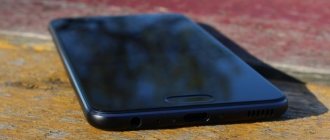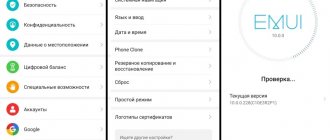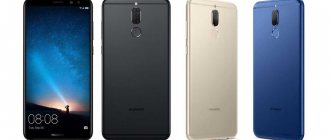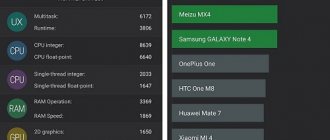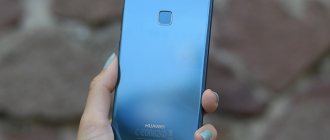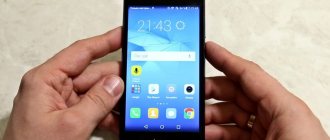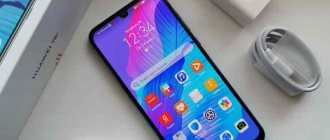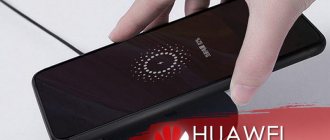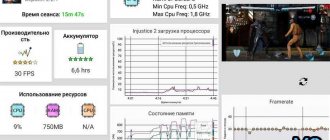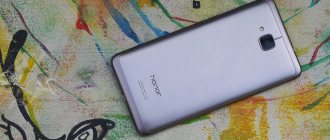At some point, the smartphone market became polarized. Companies like LG, HTC and Sony, which once set the tone, have lost their positions, and for the budget-conscious consumer, the choice of flagship has come down to Samsung and Apple products. At this time, Huawei strengthened its position. Generation after generation, flagships became better, the gap in quality and functionality with the leaders decreased, and at the same time the cost of devices and market share grew. A noticeable leap occurred with the release of Huawei P9 and the start of cooperation with Leica, then Huawei flagship cameras began to shoot noticeably better. After another two years, the new Huawei P20 Pro costs money comparable to other “tops,” and the triple camera is called the best and revolutionary solution. Let's find out if this is actually true.
LineHUAWEI P20 Pro on
Models in the line: 0
- Equipment and accessories
- Design and usability
- Face unlock, scanner and gestures
- Screen
- Platform and speed
- Software
- Screen cutout
- Sound, multimedia
- Cameras with “artificial intelligence”
- Working hours
- ITC.UA rating
Equipment and accessories
Getting to know a smartphone starts with the box and I personally like it when a company tries to please even with the packaging. Unfortunately, the P-series receives original boxes every two years (remember the P8 and P10), so the P20 Pro is greeted with a simple and concise box with standard contents: charger, cable, headset, adapter, paperclip and documentation.
Smartphones that will be officially sold in Ukraine must also be equipped with a case. The company should also bring some original accessories to Ukraine, and let’s hope that alternative options from specialized manufacturers will appear on sale (except for Spigen Rugged Armor, UAG Plasma and UAG Plyo).
Design and usability
With Huawei P9 and, especially, P10, it was clear how the company is trying to distinguish its smartphones from competitors due to the variety of not only colors, but also body textures. When creating the Huawei P20 Pro, on the contrary, they decided to follow a more familiar and understandable path - they created a glass flagship with a metal frame.
Fortunately, some experiments were necessary, and due to the unique iridescent Twilight (purple) color, the device stands out from similar models - no one has done this before. In Ukraine, the smartphone will be sold in two body colors - purple and black. The latter also looks interesting and has a matte frame. In general, the entire color palette this time turned out to be successful, because both the blue and pink options look beautiful.
Otherwise, the P20 Pro is perceived as neutral. The edges are rounded, and we tried to make the transition between glass and metal as smooth as possible. The power and volume keys are on the right, the slot for two NanoSIMs is on the left, and the Type-C connector is on the bottom. Also included were not only logos and camera optics parameters, but also service information with certification marks. Without the latter, everything would look a little neater.
In terms of ease of use, the Huawei P20 Pro does not stand out as anything special. The case is medium in size and can be operated with one hand. Like all glass smartphones, it often feels slippery, and the “back” collects fingerprints well. You should be especially careful if you are used to talking with your phone pressed against your cheek with your shoulder - in this case, it may accidentally slip out.
All three cameras protrude above the surface of the body, especially the main and tele-modules, covered with a common glass. Oddly enough, this does not lead to noticeable swaying of the smartphone lying on the table.
Given the glass body and protruding cameras, many will probably want to get a case, although on the test device, after two and a half weeks of relatively careful use, only a couple of micro-scratches appeared on the bottom.
We also note the presence of dust and moisture protection according to the IP67 standard - the smartphone can be “bathed” in fresh water, which has become a standard feature for most flagships.
⇡#Appearance, ergonomics and software
At first glance, Honor 20 and 20 Pro are the same smartphone, just called differently. When you look at them from the front, this is the case – the design is identical. The 6.26-inch screen spilled over the entire front panel, taking up 91.4% of its area and allowing only the front camera island in the upper left corner. The tiny “chin” and the narrow space above the display, where, nevertheless, it was possible to place the earpiece, are essentially not counted.
But upon second glance, especially at the back of the smartphone, you can already notice the difference. The camera unit in Honor 20 Pro is organized differently: due to the presence of a laser rangefinder that helps the hybrid autofocus system, it was necessary to move the flash away from the main unit with three lenses, combining it with the tiny optics of the macro camera. The overall style, of course, remains unchanged.
Honor 20 Pro, front panel: in the upper left corner there is a front camera, directly below the top edge there is a slot for the earpiece with a status indicator
Honor 20 Pro, rear panel: in the upper left corner there is a block of three cameras and a laser that helps autofocus, a little to the right there is a flash and an additional camera for macro photography
But the dimensions have changed. Two of the four cameras on the Honor 20 Pro are equipped with optical stabilizers, which in itself could cause the gadget to swell slightly. In addition, it has a more capacious battery (4000 mAh versus 3750 mAh). As a result, the Honor 20 Pro is half a millimeter thicker than the Honor 20. And eight grams heavier. Of course, this is not felt in any way in practice, the gadget is perceived in much the same way - it is relatively compact, it easily fits into any pocket, and with some skill it can be operated with one hand. These are the advantages of using a screen with a diagonal of 6.26 inches versus 6.4-6.7 inches, as is now most often the case when we talk about near-flagship devices.
Honor 20 Pro, left side: slot for two nano-SIM cards
Honor 20 Pro, right side: lock key combined with a fingerprint scanner, as well as a volume key
Honor 20 Pro is available in two colors: turquoise (Phantom Blue) and dark purple (Phantom Black). Both look great - the glass body shimmers, changing color depending on the lighting. Both Honor 20 and Honor 20 Pro claim to be the most beautiful smartphones of the year. With one correction - the joints on the rear panel are not made neatly, the glass is glued in with a noticeable gap.
Honor 20 Pro, top edge: microphone and IR sensor
Honor 20 Pro, bottom edge: microphone, USB Type-C port and main speaker
The set of controls and functional elements in general, located around the perimeter of the smartphone, is identical in the Honor 20 and 20 Pro: the fingerprint scanner is integrated into the lock key, there is no mini-jack, but there is an IR sensor. Despite the glass case, neither moisture protection nor wireless charging were added to the Pro version.
The fingerprint scanner, unlike Honor 20, does not cause negative emotions. Relatively small in area, the capacitive sensor here works stably, but without hypersensitivity. At least a careless touch will no longer unlock the smartphone in your pocket. The manufacturer has clearly improved this point in the firmware. The face recognition system using the front camera is also in place and works fine. But it’s safer to use a fingerprint scanner.
Lock button combined with a fingerprint scanner
There are no differences in software between the Honor 20 and 20 Pro, and there couldn’t be any. Both smartphones run on Android version 9.0 Pie with the proprietary Magic UI 2.1.0 shell - essentially the same EMUI, but with several proprietary services like the Honor store (where you can buy more devices from both this brand and Huawei), a specific selection of themes and screen wallpaper and the presence of advertising in some basic applications (like the theme store). Honor 20 Pro is not the cheapest smartphone, but such is the fate of “discount” brands. You have to pay for everything, one way or another.
Screenshot gallery
View all images (15)And if there were no questions about working with the fingerprint scanner this time, there were questions about the general behavior of the gadget - unlike the Honor 20, which was not obstinate. The smartphone regularly showed obstinacy when trying to connect to Wi-Fi networks, got stuck when connecting to a Bluetooth headset (I had to reboot the gadget), and disconnected from the mobile Internet several times for no reason. Probably - and almost certainly - these are problems with a specific instance, but the general trend is not encouraging. The smartphone seems to be rejecting an unfriendly operating system in anticipation of its own, authored by Huawei.
Face unlock, scanner and gestures
Huawei P20 Pro has received a face unlock feature using the front camera. This unlocking method turned out to be quick and convenient to use; the camera recognizes the owner well even in the twilight or wearing glasses, and failures occur only in the presence of bright backlight or in the dark. In the latter case, after a few seconds, the screen brightness increases to “illuminate” the face.
The smartphone also retains the usual fingerprint scanner located under the screen. It seems that it works even faster than in previous Huawei smartphones. The location of the sensor is chosen as successfully as possible - it is convenient to unlock the device both while holding it in your hands and when it is lying on the table.
As before, the sensor can be used for control instead of on-screen keys. Well, Huawei also implemented an additional control method, when the buttons are replaced with an oblong strip on the screen - the same gestures work with it as with the scanner. The latter option is reminiscent of the control scheme of the iPhone X and the similarities do not end there.
Screen
The Huawei P20 Pro has a 6.1-inch OLED screen with a resolution of 2240 by 1080 pixels. Due to the presence of the cutout, the display is slightly elongated in height; it has proportions of 18.7 to 9. The screen is covered with glass with an oleophobic coating and rounded edges, and a protective film is glued to it from the box.
According to our measurements, the maximum screen brightness when filled with white is 409 cd/m², and the minimum is 3.7 cd/m², but do not forget that in OLED matrices the brightness changes dynamically and depends on the displayed image, so the display “shines” when in use brighter, especially on a sunny day outside.
"Normal" color mode
Calibration was performed at the usual good level, all parameters are normal, and the color gamut depends on the selected color rendering profile. In normal mode, color rendition is close to IPS matrices, and the coverage is slightly wider than the sRGB space.
Vivid color mode
Vivid mode provides wider coverage and richer colors, making the screen comparable to other OLED and some IPS displays. There is also the possibility of manually adjusting the color temperature, a function for automatically adjusting the temperature depending on the lighting, an eye protection mode and the ability to increase sensitivity for operation with gloves.
According to subjective impressions, I liked the screen. Full HD+ resolution is enough to make the image smooth, only the most eagle-eyed can see individual pixels. Having a variety of settings allows you to customize everything for yourself, although in my case the default settings turned out to be quite suitable. In general, it’s a screen familiar to flagships, with no complaints.
Huawei P20 display – 85% area
Huawei P20 received a 5.8-inch LCD display, P20 Pro - 6.1 inches, it was made using OLED technology. Displays occupy approximately 85% of the front surface area of smartphones. The stated characteristics are 16.5 million colors, color saturation (NTSC) for Huawei P20 is 96%, for P20 Pro it is 112%.
Without numbers and briefly, the displays are excellent. However, for modern flagships this is already standard.
Platform and speed
The smartphone is built on the proprietary platform Kirin 970 and at the start of sales will be available in a single version with 6/128 GB of memory. There is no possibility of expansion using memory cards; the slot is not “hybrid”. The SoC is made using a 10 nm process technology, is equipped with a special NPU module for implementing “artificial intelligence” functions and is already familiar to us from the Mate 10 Pro, we also talked about it in a separate report.
The entire set of modules required for flagships is available: NFC, dual-band Wi-Fi, Bluetooth 4.2 with apt-X HD, Type-C (USB 3.1), as well as an infrared port for controlling household appliances. The smartphone supports the simultaneous operation of two SIMs in a 4G network, and is also equipped with a fast modem (Cat 16/Cat 18, up to 1.2 Gbit/s) - within the first Ukrainian LTE networks we were able to see speeds of up to 95 Mbit/s.
In benchmarks, Huawei P20 Pro shows results at the level of current flagships, although it is slightly inferior to devices on Snapdragon 845 in the same Antutu. When running tests cyclically, the smartphone gets a little warm, but during normal use, even during games, there is almost no heating.
The speed of operation in actual use is excellent - there are no complaints about the smartphone. Everything is also good with games - PUBG Mobile, Guns of Boom, Modern Combat 5, Asphalt Extreme worked smoothly and without stuttering, although it is believed that developers do not adapt their titles very well to the Mali-G72 MP12 GPU (and Mali accelerators in general).
Huawei P20 Pro results in AnTutu Benchmark
In the popular AnTuTu benchmark, the Huawei P20 Pro smartphone scores an average of about 210,479 points. This figure, like all those given below, was taken from the official website of the developer of this software.
Comparison with other smartphones from the ratings of different years
| Model | Platform | Memory | CPU rating | UX assessment | 3D assessment | Overall rating | |
| 1 | Samsung Galaxy Note9 (Exynos 9810) | Exynos 9810 | 6 Gb + 128 Gb | 85959 | 53725 | 96985 | 244758 |
| 2 | Samsung Galaxy Note 9 (Exynos 9810) | Exynos 9810 | 8 Gb + 4 Gb | 84438 | 53320 | 96382 | 242496 |
| 3 | Apple iPhone X | Apple A11 Bionic | 3 Gb + 256 Gb | 92362 | 48880 | 85583 | 236983 |
| 4 | Apple iPhone 8 Plus | Apple A11 Bionic | 3 Gb + 64 Gb | 51240 | 74817 | 76133 | 217210 |
| 5 | Google Pixel 2 XL | Snapdragon 835 | 4 Gb + 128 Gb | 71304 | 43703 | 90561 | 214492 |
| 6 | Huawei Honor V10 | Kirin 970 | 6 Gb + 64 Gb | 70482 | 44254 | 85061 | 213381 |
| 7 | Huawei Mate 10 Pro | Kirin 970 | 6 Gb + 128 Gb | 71590 | 44515 | 83204 | 213133 |
| 8 | OnePlus 5T | Snapdragon 835 | 8 Gb + 128 Gb | 72934 | 46748 | 83902 | 212558 |
| 9 | Apple iPhone 8 | Apple A11 Bionic | 2 Gb + 64 Gb | 62647 | 74239 | 60092 | 212175 |
| 10 | Huawei Mate 10 | Kirin 970 | 4 Gb + 64 Gb | 71045 | 44295 | 82622 | 211486 |
| 11 | Huawei P20 Pro | Kirin 970 | 6 Gb + 128 Gb | 71808 | 46445 | 78756 | 210479 |
The rating of devices on the official AnTuTu website is updated once a month. Old data is available via Web Archive.
Top
Software
Huawei P20 Pro runs Android 8.1 and EMUI 8.1. The eighth version of the proprietary interface offers an updated design for many standard icons and stands out with support for standard Android 8.1 features such as shortcuts available by pressing and holding application icons.
Additional EMUI functionality has not changed noticeably. As before, you can choose to display the interface with or without a separate application menu, swiping down on the desktop brings up a convenient search for your smartphone and applications, adjusts the location and number of icons in the notification panel, and the screensavers on the lock screen can change automatically.
Once again, I can repeat that I personally like EMUI in terms of ease of use, but I would not refuse a pure Android style theme created by Huawei - similar ones can be found on forums and in the Play Market, but they are not all made carefully enough. This desire is due to the fact that by default in EMUI, many icons and even interface elements are very reminiscent of iOS - settings, clock, voice recorder, “lock” on the lock screen when unlocking by face, camera application, and so on. At the same time, after the final customization, all this is no longer so noticeable.
Screen cutout
Many flagships at the beginning of the year acquired a cutout in the screen in the style of the iPhone X, and the P20 Pro was no exception. The main thing you need to know about it is that the cutout is small and does not affect functionality or ease of use. The status bar contains a normal number of icons; depending on the application, the status bar is colored in the color of the program or turns black. YouTube video stretches to the cutout.
For those who can’t live with the notch (but will still buy the Huawei P20 Pro :) ) they’ve added a hiding function - the areas on the left and right will turn black and only white icons will be displayed on them, which looks quite interesting. Depending on the viewing angle, the cutout may be completely invisible and merge with the frame.
Sound, multimedia
Huawei P20 Pro also boasts the presence of stereo speakers; the role of the second speaker in it is played by the earpiece. The smartphone sounds loud and clear, but the sound is slightly lacking in volume and bass - the company has produced generally good, but not the best of similar speakers.
There are no comments regarding the vibration and dynamics during calls. There is a volume reserve for comfortable communication in most conditions.
In general, there are no problems with playing music on headphones. Bluetooth supports current codecs (aptX HD and others) for transmitting high-quality audio - it seems that by massively abandoning the usual mini-jack, companies are pushing us towards exactly this way of listening to music. I have already followed it, and was completely satisfied with the performance of the P20 Pro paired with a Shure SE215 connected to a MEE audio BTX1.
When using an adapter and regular headphones, the Dolby “enhancer” works by default, which replaced the previous DTS and Histen. The Dolby add-on tries to make the sound more rich and voluminous - depending on the music, the sound can become either better or slightly worse. Without Dolby, the sound becomes neutral and even “dry”, analytical.
Cameras with “artificial intelligence”
Huawei P20 Pro received three main cameras at once: a main sensor with a resolution of 40 MP (f/1.8, 27 mm), an additional 8 MP with a telephoto lens (f/2.4, 80 mm) and a monochrome 20 MP (f/1.6, 27 mm). The camera system is also equipped with laser autofocus with an increased operating range (up to 2.4 meters) and a color temperature sensor.
How it works? The main camera is equipped with a special filter (Quad Bayer Structure) and to obtain information about one pixel in the image, information from several neighboring pixels is used, so by default the smartphone takes pictures with a resolution of 10 megapixels. The monochrome module, due to its lighter optics and wide dynamic range, is used to obtain additional information about lighting. The telephoto lens works when zooming.
The sensors are connected to hardware, namely the NPU module, which is responsible for scene recognition, autofocus, and so on. In practice, AI functions can work not only in the camera, but their work is best seen when shooting.
Generally speaking, this whole tandem of technologies works great - the Huawei P20 Pro camera is truly one of the best, if not the best solution on the market at the moment. Periodically, the software lets you know that it has recognized the scene and the image on the screen may change slightly depending on the presets specified by the manufacturer.
Blur background
Most images have very wide dynamic range, as if they were taken in HDR mode, and good detail. However, pattern recognition can also give somewhat strange results; when shooting the same scene, you can get noticeably different frames. Therefore, it is good that scene recognition can be completely turned off in the settings or when shooting a specific scene, although in general there is no such need.
Examples of successful (and not so successful) scene recognition (AI) work
When shooting at night, the multiple exposure mode is often, but not always, used, when the device takes one photo for 4 seconds - during this time it “glues” several frames together. The nice thing is that most photos are sharp in this case, which allows Huawei to claim that they have implemented long-exposure photography without a tripod, although this is not a technically correct claim. This mode can be activated separately, it is called “Night”.
Long exposure photos
Also noteworthy is the ability to shoot with a five-fold zoom with virtually no loss of quality. If the AI decides that you are shooting macro, the camera switches to shooting at 2x zoom.
Examples of zoom operation
There is also the ability to take frames at a resolution of 40 megapixels, but there is little practical sense in it - in this mode the AI functions work differently, there is no zoom option, no high ISO mode, and so on.
Photo in 40 MP resolution
They didn’t forget about video recording, which Huawei had problems with before. In particular, when shooting Full HD (30 fps), AI stabilization works. The shooting angle becomes narrower, but the picture turns out to be perfectly stabilized even when walking.
When shooting Full HD (60 fps) and 4K (30 fps), AI stabilization does not work, but in the second case, the image differs minimally from the stabilized video, but the videos turn out “jerky.” There is also a slow motion mode in HD at 960 fps, but its performance still leaves much to be desired.
The camera application itself was also redesigned, which began to closely resemble the one on the iPhone. Now switching between the main shooting modes occurs using the “wheel”, the extreme position of which (“More”) hides additional modes for shooting monochrome photos, HDR, panoramas, and so on.
The front camera with a resolution of 24 megapixels (f/2.0) lacks autofocus, but takes self-portraits of decent quality. It (like the iPhone) has a mode for emulating studio 3D lighting.
The original pictures and videos can be downloaded to Google Drive.
Appearance
In the new generation of Huawei smartphones, they abandoned the Plus prefix in the name, and it’s difficult to call a Plus smartphone, the size of which, despite the 6.1-inch diagonal, is not much larger than the 5.2-inch smartphones of previous years. Due to the frameless screen, the company was able to significantly reduce the dimensions.
The screen is the main new design element. Almost the entire front side of the smartphone is occupied by a large 6.1-inch OLED screen. Thin frames, a small strip under the screen with a fingerprint scanner located in it, which can also act as a control button. The upper part of the screen is almost close to the borders of the smartphone, with the exception of a small part in the middle, which houses the proximity and light sensors, the earpiece and the front camera. It is this protrusion that is usually called either a bang or a unibrow.
By the way, pay attention to the corners of the screen, the screen itself, and not the smartphone - they are slightly rounded, which gives the screen a very pleasant and unusual appearance.
Looking ahead, let's say that you can hide the above-mentioned unibrow (in the manufacturer's terms this is called a “controller”). In the screen settings, you can select an option in which service statuses will simply be displayed on the bars to the right and left of this controller, and the bar itself will turn black. This allows you to save useful screen area by displaying all network statuses, wi-fi, battery charge, etc. in these areas. It is in this mode that it is most pleasant to work with the phone, and it looks nicer than just a smartphone with a cutout in the screen.
There are three cameras on the reverse side. The main one is 40 MP with an RGB sensor, the additional one is 20 MP with a b/w sensor, and the third is an 8 MP camera with a telephoto lens that allows you to create some kind of optical zoom. But we'll talk about the cameras themselves later. Below them is a flash and the proud inscription LEICA. There is also additional information about the focal length of the camera; when converted to EGF, it turns out to be 27-80 mm (three times zoom), at 27 mm the aperture is f/1.6, and at the telephoto range it is 70 mm at f/2.4. The back of the smartphone is made of tempered glass, under which The housing is blue. Also, Huawei P20 Pro is presented in black and a very interesting color option, called Master AI (professional photo assistant). Master AI determines what exactly you are photographing, what the scene is, and, based on this, sets the preset camera settings. Moreover, it determines quickly and accurately. Point the camera at a cat - the cat message pops up and the program adapts to shooting animals; portrait mode is determined in the same way, for example, shooting food, flowers, landscapes, etc. We must pay tribute to this assistant - the pictures really turn out to be of higher quality and more interesting.
ISO test
ISO 400
ISO 800
ISO 1600
ISO 3200
ISO 6400
For a smartphone camera, the result is simply excellent. Thanks to this, as well as an improved image processing algorithm, the camera is able to shoot even at night. The “night shooting” mode allows you to increase sensitivity to ISO 102400, but this is achieved through software - the smartphone takes several pictures, then combines them into one using a special algorithm to reduce noise and increase detail. The idea of such a solution is not new, but we have not previously encountered its use in smartphones.
Sample pictures
Panorama mode
Wide aperture mode
When this mode is turned on programmatically, the effect of a shallow depth of field is achieved, and you can also change the focus point and depth of field on already captured photographs. The aperture range is listed as f/0.95 to f/16 equivalent. The aperture value can be set both during shooting and after. You can also change the focus point after shooting. In addition, you can not only blur the background, but also apply one of the available filters to it. The principle remains the same - everything that is not included in the depth of field changes, but the subject itself remains unchanged.
The mode works both for color photographs and in monochrome mode. Most photos are pleasing to the eye, with just the right amount of blur, but too low an aperture can make the image look unrealistic; too much and harsh blur looks sloppy and turns the viewer off. Therefore, this mode must be used carefully, choosing the right angle and blur strength.
Monochrome mode
Monochrome mode was one of the main features of the Huawei P10, and remains so in the Huawei P20 PRO. A regular color sensor contains special light filters that cut off part of the transmitted light, but with further processing and interpolation it allows you to collect a color image. But if these filters are removed, we will only get the brightness component of the picture. This allows you to increase photosensitivity and expand the dynamic range of the image. But, naturally, at the output we will get a black and white image.
In the world of large cameras, there is only one modern camera with a monochrome sensor - the Leica M Monochrom. The solution is highly specialized and expensive. You can have different attitudes towards black and white photography, but in certain situations, black and white photographs look more advantageous than color ones.
Huawei P20 PRO allows you to take black and white photos in resolutions of up to 20 MP (you can also select 10 and 7 MP in the settings). The result is excellent, detailed images with an acceptable noise level even at high ISOs.
Video recording
The maximum video resolution is 4K @30 fps, Full HD is available at 60 fps, and 30 fps. Separately, in the camera menu, you can select the “Slow motion” item, which has several options for shooting slow motion video:
- 32x – shooting HD video at 960 frames per second, which with standard playback allows you to slow down the image 32 times, but with a significant limitation: it must be light enough to provide such a short shutter speed for individual frames, and shooting takes only a quarter of a second.
- 4x and 8x – slowdown by 4 and 8 times, respectively, shooting in fullHD without a limitation on shooting time.
The optical stabilizer in video shooting mode only works in Full HD @30 fps mode and in lower quality modes. There are no complaints about video shooting - focusing is confident, there are no jerks, the picture is bright and detailed.
Front-camera
The front 24-megapixel camera with autofocus and f/1.9 aperture keeps up with the high quality bar set by the main camera block. Photos are obtained with a good level of detail, the picture is clear and rich. The only unpleasant moment is the photo “beautification” mode; the smartphone tries to smooth out skin imperfections, which sometimes negatively affects the picture. Moreover, despite the fact that the setting of this function is set to zero, the effect of improving the skin still remains noticeable.
Working hours
The smartphone has a built-in 4000 mAh battery with support for proprietary SuperCharge fast charging technology. The company promises up to two days of operation under average load. In half an hour the device gains about 55% charge, in an hour - 90%, and a full charge takes 1:20. In the PC Mark test, the smartphone showed a result of 8 hours 25 minutes.
Operating time during normal use depends on many factors. For example, my usual usage scenario includes constantly synchronizing two Google accounts, running 3-4 instant messengers in the background, using Wi-Fi and mobile Internet (3G and 4G is often used to watch videos on the way to work), listening to music via Bluetooth headphones and always connected Pebble.
In this mode, the worst result I have seen is 4 hours of active screen per day of work or 5 hours of active screen per day. The best is 6 hours of screen time per day. If you turn off the smartwatch and 4G (the quality of LTE coverage in Kyiv still leaves much to be desired), then you can count on 6 hours of use with a day and a half of work. If you use the power saving mode, which disables synchronization of Google accounts and slightly reduces the average screen brightness, you can achieve two days of operation on a single charge.
You can also disable the background operation of individual applications, activate the black interface theme and “smart screen resolution” - all this slightly increases the operating time. In general, the Huawei P20 Pro turned out to be quite autonomous; you just want to get even more from a flagship with one of the most capacious batteries.
5
ITC.UA rating
Pros: design, triple cameras with AI and useful additional shooting modes, performance, good screen, capacious battery, memory capacity
Cons: price, no mini-jack and MicroSD slot
Conclusion: Over the past couple of years, we have become accustomed to the fact that new flagships do not receive many new features compared to their predecessors, and this state of affairs is perceived as normal. In this vein, the main advantage of the Huawei P20 Pro is that the company was able to take several steps forward compared to last year's models. Does the smartphone have critical flaws? No. But their competitors don’t have them either - the market leaders have long gotten rid of “childhood diseases.” Therefore, the only downsides are the expectedly high price and the usual refusal of mini-jack and memory cards. The new smartphone feels truly new, and not a slightly improved version of what we've seen before, and the P20 Pro doesn't look dull compared to its competitors - it's the first device with three cameras, and their number is consistent with the quality of the resulting images. The presence of a unique Twilight color should also play a positive role, because everyone uses identical body materials, and the user needs to be surprised with something. Huawei were able to do this, for which they receive a well-deserved “Editor's Choice”.
Specifications
| HUAWEI P20 Pro 6/128GB Twilight (51092FFA) Notify when available | |
| Type | Smartphone |
| Pre-installed OS | Android 8.1 + EMUI |
| RAM, GB | 6 |
| Built-in memory, GB | 128 |
| Expansion slot | — |
| SIM card type | Nano-SIM |
| Number of SIM cards | 2 |
| CPU | HUAWEI Kirin 970 + Mali-G72 MP12 |
| Number of Cores | 8 |
| Frequency, GHz | 2,3 |
| Battery | 4000 mAh (non-removable) |
| Diagonal, inches | 6,1 |
| Permission | 1080 x 2240 |
| Matrix type | AMOLED |
| PPI | 408 |
| Dimming sensor | + |
| Main camera, MP | 40 (f/1.7) + 20 (f/1.6) + 8 (f/2.4) |
| Video shooting | + (4K) |
| Flash | + |
| Front camera, MP | 24 (f.2.0) |
| WiFi | 802.11ac |
| Bluetooth | + (4.2, apt-x) |
| GPS | + |
| IrDA | + |
| FM radio | — |
| Audio jack | — |
| NFC | + |
| Interface connector | USB Type-C |
| Height, mm | 155 |
| Width, mm | 73,9 |
| Thickness, mm | 7,8 |
| Weight, g | 180 |
| Protection from dust and moisture | + |
| Type of shell | monoblock (non-separable) |
| Housing material | metal/glass |
| Case color | blue/turquoise |
| Keyboard type | screen input |
| More | accelerometer, proximity sensor, gyroscope, Hall sensor, compass, fingerprint scanner, fast charging support |
Specifications
Before the review itself, it would not be superfluous to list the technical characteristics of the Huawei P20 Pro.
| Display | 6.1”, FullHD (2240×1080), 408 ppi, automatic brightness control, aspect ratio 18.7:9 (2,074:1), OLED matrix, brightness 400 cd/m2, 10 touches |
| Chipset | HiSilicon Kirin 970, 8 cores (4 × Cortex-A73 2.36 GHz + 4 × Cortex-A53 1.8 GHz), 64 bit, 10 nm; i7 coprocessor |
| Graphic arts | Mali-G72 |
| RAM | 6 GB LPDDR4 SDRAM |
| Persistent memory | 128 GB (UFS 2.1) |
| Memory card | No |
| Battery | Li-Pol 4000 mAh |
| Main camera | 3 modules:
Laser focusing, color temperature sensor |
| Front-camera | 24 MP (without stabilization, 26 mm, f/2.0) |
| operating system | Android 8.1, EMUI 8.1 |
| Interfaces | Wi-Fi 802.11 a/b/g/n/ac (2.4/5 GHz) 4x4 MIMO, Bluetooth® v4.2, USB Type-C 3.1, NFC, IR transmitter, GPS, GLONASS, BDS |
| Sensors | Sensors: fingerprint (front panel), face recognition, acceleration, electronic compass, gyroscope, proximity, light sensors |
| Dimensions | 149.1×70.8×7.65 mm |
| Weight | 165 grams |
